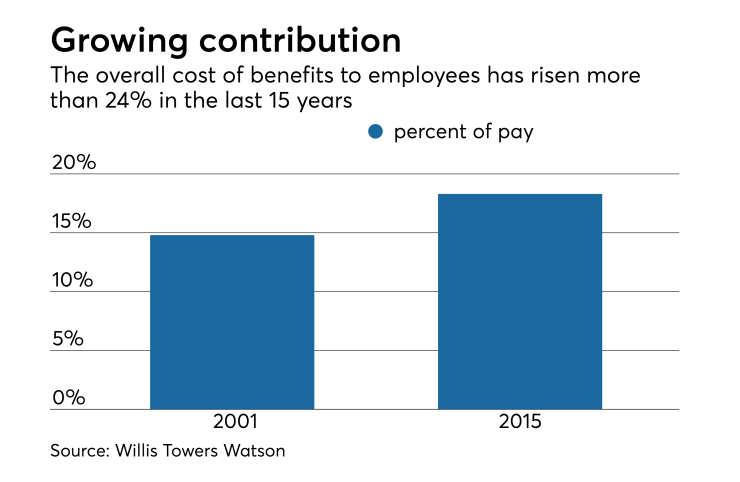Are employees getting the benefits they really want? Maybe not, a recent Willis Towers Watson analysis found. The study, “
Specifically, the study shows the overall cost of benefits — retirement, healthcare and post-retirement medical benefits — climbed from 14.8% of pay in 2001 to 18.3% of pay in 2015, for a total increase of 24%, driven largely by a doubling in healthcare benefit costs.

While healthcare costs more than doubled from 5.7% to 11.5% of pay, retirement costs, which include defined benefit, defined contribution and post-retirement plans, decreased by 25%, falling from 9.1% to 6.8% of pay.
In the past decade and a half, benefit costs have done an about-face.
“In 2001, active healthcare costs comprised about two-fifths while retirement benefits made up the remaining three-fifths,” the analysis reads, “By 2015, the ratio had flipped, with active healthcare benefits accounting for slightly less than two-thirds of costs and the retirement share dropping to slightly more than one-third.”
“Healthcare benefits are eating up a larger portion of dollars while the amount spent on retirement programs is on the decline,” says John Bremen, managing director of the Human Capital and Benefits division at Willis Towers Watson. “This reallocation has major implications for employers and employees alike.”
The study explains that the decrease in retirement costs is a result of the large shift in employers offering a traditional defined benefit plan to usually replacing them with enhancements to their defined contribution plan. Even though defined contribution plan costs rose by 1.6 percentage points between 2001 and 2015, this increase was not sufficient to offset the 2.9 percentage point decrease in the cost of defined benefit plan costs.
Also see: “
While Willis Towers Watson’s Global Benefits Attitudes Survey notes that employees value their healthcare benefits just as much as their retirement benefits, many employees seem to have reached the maximum they are able or willing to pay for healthcare benefits. Also, employees are concerned about their current and future financial circumstances and worry that they will not have sufficient funds saved for retirement and will thus have to work past the usual retirement age.
Taming costs
Alexa Nerdrum, a senior retirement consultant at Willis Towers Watson, says there are a couple of ways employee benefit advisers can help employers tame these costs.
“I think one would be for employers really to identify and understand the financial needs and the priorities of the workforce. I think for a long time we’ve had employers kind of construct this as a one-size-fits-all,” says Nerdrum.
Nerdrum suggests that employers may need to reevaluate how benefit dollars are allocated to better fit the needs and concerns of their employees. While each company’s solution would be different, Nerdrum notes that employers could explore using tax-efficient saving mechanisms, like health savings accounts, and also just spend more wisely on healthcare.
“The other big piece would be improving financial literacy. By and large, a lot of employees just don’t understand what they need to be doing and how to make the right choice,” says Nerdrum. “So — to the extent employers can invest in education, technology and tools to improve financial literacy — I think that’ll go a long way toward somebody not just continuing the status quo and making a right decision for them. In turn [this leads] to healthier choices, which kind goes down the line of lowering employer costs and improving the financial wellness of the workforce.”





